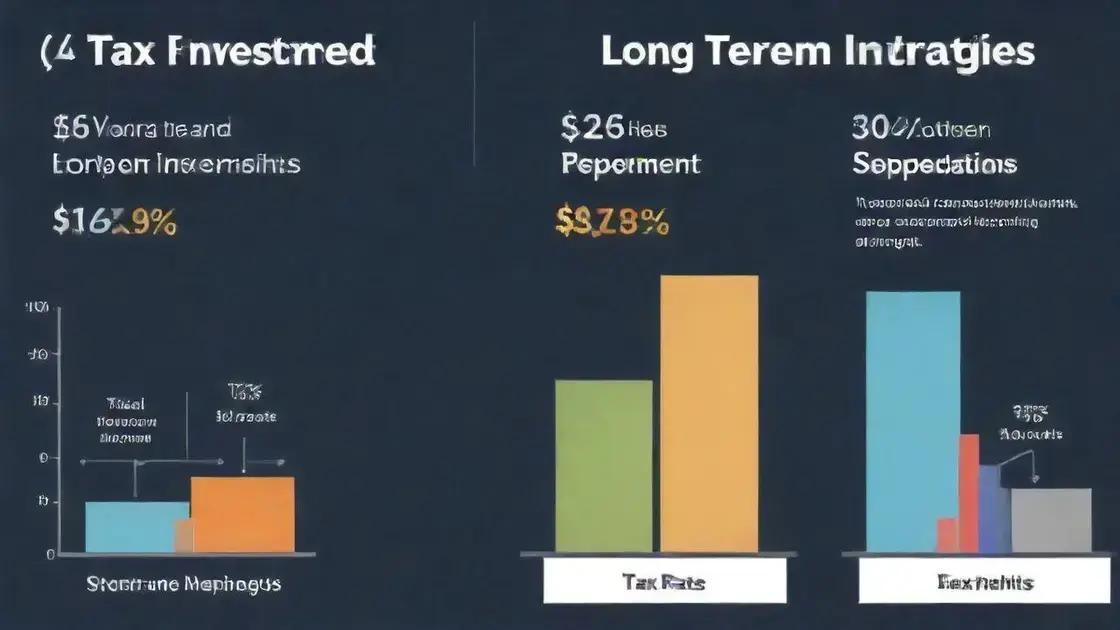Treatment capital gains rules explained simply

The treatment of capital gains rules involves understanding the distinction between short-term and long-term gains, applying strategies to minimize taxes, and keeping updated on recent regulatory changes to enhance investment outcomes.
Treatment capital gains rules can feel overwhelming, right? But understanding how these rules affect you is crucial for smart financial planning. Let’s dive into the essentials and see how they apply to your investments.
Understanding capital gains and losses
Understanding capital gains and losses is vital when it comes to taxation on your investments. Knowing the difference between these two can help you manage your finances effectively.
When you sell an asset for more than you paid for it, that profit is known as a capital gain. Conversely, if you sell an asset for less than what you bought it for, you incur a capital loss. Both gains and losses are crucial in determining your overall tax liability.
Types of Capital Gains
Capital gains are typically classified into two types: short-term and long-term. The classification depends on how long you’ve held the asset.
- Short-term gains: These are profits from assets held for one year or less. They are usually taxed at ordinary income rates.
- Long-term gains: These gains occur when the asset is held for more than one year and are taxed at lower rates, promoting longer investment periods.
- Offsetting losses: You can use your capital losses to offset the capital gains you’ve made during the year, which can lower your taxable income.
Understanding these types can aid in your investment strategy. If you’re aware of how long you plan to hold an asset, you can strategize accordingly. For instance, if you think you might sell for a profit soon, it might be best to hold the asset slightly longer to benefit from lower long-term tax rates.
How Losses Affect Your Taxes
On your tax return, capital losses can be particularly beneficial. They can offset capital gains and, when your losses exceed your gains, you can even deduct up to $3,000 from other income sources.
Be mindful, though, of the wash sale rule, which states that if you sell a stock at a loss, buy it back within 30 days, you cannot claim that loss on your taxes. This ensures that taxpayers are not taking advantage of short-term trades solely for tax benefits.
In summary, recognizing how capital gains and losses operate is fundamental in planning your investments and tax strategies effectively. Stay informed about these rules to maximize your financial outcomes.
How the treatment of capital gains works
How the treatment of capital gains works is essential knowledge for investors. This can affect how much tax you pay after selling your assets.
When you sell an asset and make a profit, this profit is recognized as a capital gain. The tax treatment on the gain can differ based on its classification as either short-term or long-term.
Short-term Capital Gains
Short-term capital gains arise from the sale of assets held for one year or less. These gains are taxed at your ordinary income tax rate. This means that, depending on your total income, you might pay a higher percentage of tax on these short-term gains.
- Higher tax rates: Since short-term capital gains are taxed like ordinary income, they can push you into a higher tax bracket.
- Frequent trading: Active traders often incur short-term gains, leading to higher tax bills.
- Investment strategies: Understanding this can help you plan your selling strategies more effectively.
Switching tactics can optimize your tax impact. For instance, you might choose to hold onto an asset a bit longer to benefit from long-term tax rates.
Long-term Capital Gains
Long-term capital gains apply to assets sold after holding them for more than a year. These gains are generally taxed at reduced rates, which can be as low as 0% or 15%, depending on your income level.
This lower tax rate incentivizes long-term investment strategies. By holding assets longer, you not only reduce your tax liability but also allow your investments more time to potentially gain value.
Long-term gains also provide an opportunity to regain losses through strategies like tax-loss harvesting. By offsetting your gains with losses, you can lower your taxable income overall.
In summary, understanding the treatment of capital gains is crucial for managing your investments efficiently. Whether you’re trading frequently or holding assets longer, knowing the implications can lead to better financial decision-making.
Differences between short-term and long-term gains

The differences between short-term and long-term gains are crucial for anyone involved in investing. These differences primarily relate to the time you hold an asset before selling it and the tax implications that follow.
Short-term gains apply to assets that you sell after holding them for one year or less. These gains are taxed at the same rates as your ordinary income, which can be significantly higher than long-term capital gains rates.
Tax Implications
When it comes to taxes, understanding how short-term gains are taxed is essential. Selling an investment quickly might result in higher taxes.
- Higher tax rates: If you sell within a year, you pay tax based on your income bracket, which may be higher.
- Increased taxable income: Short-term gains can push you into a higher tax bracket overall.
- Impact on investment strategy: Frequent trading might not be the best approach if large tax bills deplete your profits.
In contrast, long-term gains arise from assets held for more than one year. These gains benefit from lower tax rates, often between 0% to 20%, depending on your income level.
Investment Strategy
Long-term investing is encouraged, partly because of the tax benefits. Holding onto investments rewards you with a reduced tax bill, and you also have a better chance of benefiting from market growth.
Investors often consider their time horizon when planning their strategy. Understanding that long-term capital gains are taxed more favorably can influence decisions about when to sell investments.
By gravitating towards a long-term approach, investors can maximize returns while minimizing tax liabilities. Recognizing the differences between short-term and long-term gains not only helps in tax planning but also shapes overall investment strategies.
Strategies to minimize capital gains taxes
Implementing strategies to minimize capital gains taxes is essential for smart investing. With the right approach, you can lower your tax burden and maximize your profits.
One effective method is to hold onto your investments for more than one year. By doing so, you can benefit from lower long-term capital gains tax rates. This simple shift in strategy can yield significant tax savings over time.
Use Tax-Loss Harvesting
Tax-loss harvesting is another useful technique. This involves selling losing investments to offset gains from profitable ones, which can reduce your overall taxable income.
- Offset taxable gains: By strategically selling losing assets, you can counterbalance gains and lower your tax burden.
- Carryover benefits: If your losses exceed your gains, you can often apply up to $3,000 of the excess loss against other income.
- Reinvestment opportunities: Selling a loss can free up capital to reinvest in more promising projects.
Another strategy involves utilizing tax-advantaged accounts. Investing through accounts such as Roth IRAs or 401(k)s can help you defer or avoid taxes on your capital gains.
Timing Your Sales
Being strategic with your timing can also help reduce capital gains taxes. If you anticipate a change in income levels, you might want to delay sales until a lower income year.
Gift assets to family members or charities can also be beneficial. By gifting appreciated assets, you can transfer the tax liability to the recipient, who may pay less tax on the gain.
In addition, consider the impact of state taxes on capital gains. Some states have lower or no capital gains tax. If you’re thinking of relocating, this could be an essential factor.
By carefully planning your investment strategy and considering these methods, you can effectively lower your capital gains taxes and keep more of your hard-earned money.
Recent changes in capital gains tax regulations
Recent changes in capital gains tax regulations have significant implications for investors. Staying informed about these changes can help you make more strategic financial decisions.
One major update is the adjustment of tax rates. Depending on your income, the long-term capital gains tax rate may shift, affecting how much you pay when you sell assets.
Changes to Tax Brackets
The tax brackets for capital gains can vary, and adjustments often happen due to inflation. This means that what was applicable last year might not be the same this year.
- Higher income thresholds: Some regulations increase the income thresholds, allowing more people to fall into lower tax brackets.
- New tax rates: With recent policy shifts, long-term capital gains may now be taxed at different rates than before, affecting your after-tax income.
- Impact of state taxes: Some states have also adjusted their capital gains taxes, which adds another layer to consider when planning your investments.
Another significant change in regulations concerns the way inflation affects gain calculations. This involves adjusting the purchase price of assets to account for inflation, which can lower your taxable capital gains. Understanding this adjustment can help investors strategize on when to sell assets for maximum benefit.
Mandatory Reporting Requirements
Recent regulations have also led to stricter reporting requirements for capital gains. Investors must now report capital gains more systematically, which means detailed record-keeping is essential.
Some investment platforms automatically track and report these figures, making it easier for investors to comply. Understanding these changes can simplify your tax preparation process.
With the landscape of capital gains taxes evolving, staying up-to-date on recent changes in tax regulations is vital for maintaining your financial strategy. By carefully navigating these updates, investors can potentially save money and enhance their investment outcomes.
FAQ – Frequently Asked Questions about Capital Gains Tax
What are capital gains?
Capital gains are the profits made from selling an asset for more than you purchased it.
How can I minimize my capital gains taxes?
You can minimize capital gains taxes by holding onto assets longer, using tax-loss harvesting, and understanding the current tax regulations.
What is the difference between short-term and long-term capital gains?
Short-term capital gains are from assets held for one year or less and are taxed at ordinary income rates, while long-term gains are for assets held longer and are taxed at a lower rate.
Why is it important to stay updated on tax regulations?
Staying updated helps you make informed decisions that could reduce your tax liabilities and maximize your investment returns.






